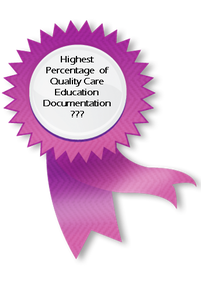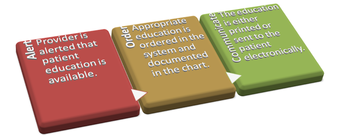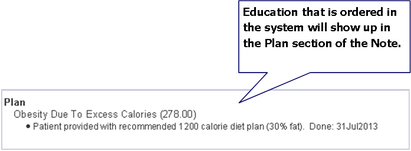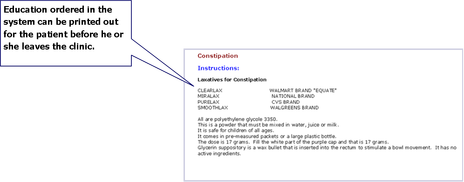
One of my very favorite pediatricians (and she knows who she is) made the comment a couple of weeks ago that she thought her clinic should be winning a pizza party for something other than clicking a box to document education. She suggested that they should be winning for something like, well, quality patient care.
I absolutely agree with her. They should be awarded for quality patient care.
As I mentioned last month, I am a parent who truly appreciates the quality of care my children have received from them. And as an EHR analyst, I’ve been able to work with the clinic to help set up templates to document some of the grant initiatives they’ve been awarded recently (Ever heard about the ReadNPlay books?) And when it comes to residency training, this group has really demonstrated their commitment to medical education and making sure that their residents are well prepared, not only for providing excellent patient care, but for also documenting excellent care in an electronic health record.
I say all of this—not to brag on the clinic again this month—but to suggest that checking a box and providing quality care can go hand-in-hand. Maybe we could’ve rephrased our award to be “Highest Percentage of Quality Care Education Documentation.” I little wordy, perhaps, but do you see what I’m getting at?
The Meaningful Use initiative wasn’t created to demean or devalue the care providers are already giving; it was designed, in part, to help document that care in a meaningful way, or, more specifically, in a way that can be pulled as data later—for research, for quality improvement, for education. It was also implemented to ensure providers are equipped with EHRs that are designed to be a secure tool for them, not just another database.
Admittedly, it isn’t a perfect program, and what new quality health initiative is? Yes, providers do have to spend more time clicking boxes, and, yes, the system freezes up sometimes, and, yes, there are “bugs” that creep around the system, just to get under our skin.
Not that these imperfections are directly Meaningful Use centered; in fact, most of the things users complain about are technology centered. How many times have you found yourself grumbling about your Smartphone being too slow or forgetting your online banking password? In fact, just a few days ago, I had to call my credit card issuer because their website locked me out…imagine that! But, I also can’t imagine not having my Smartphone, or not being able to check my bank account balance, or not being able to pay my bills online. I never want to balance a paper checkbook using canceled checks again. And I would guess that none of our users can imagine using a paper chart again.
But as we start preparing for the next stage of Meaningful Use, it’s interesting to look at how this next stage is trying to improve from the first stage of the program and really make use of developing technologies. According to CMS, Stage 2 Meaningful Use was designed to support “the aims and priorities of the National Quality Strategy. Specifically, Stage 2 meaningful use criteria…encourage[s] the use of health IT for continuous quality improvement at the point of care and the exchange of information in the most structured format possible." As part of the Affordable Care Act, the National Quality Strategy is a national endeavor to “align public and private interests to improve the quality of health and health care for all Americans.”
It’s guided by three aims to provide better, more affordable care for people and communities, as well as six priorities:
Let’s use patient education to illustrate how these priorities work. For Stage 2, core measure #13 requires using a certified EHR to identify and to provide patient-specific education for more than 10% of unique patients. As an improvement upon Stage 1, our EHR will be required for Stage 2 to identify appropriate educational resources for the patient, based on either his or her problem list, medication list, or laboratory test results.
I absolutely agree with her. They should be awarded for quality patient care.
As I mentioned last month, I am a parent who truly appreciates the quality of care my children have received from them. And as an EHR analyst, I’ve been able to work with the clinic to help set up templates to document some of the grant initiatives they’ve been awarded recently (Ever heard about the ReadNPlay books?) And when it comes to residency training, this group has really demonstrated their commitment to medical education and making sure that their residents are well prepared, not only for providing excellent patient care, but for also documenting excellent care in an electronic health record.
I say all of this—not to brag on the clinic again this month—but to suggest that checking a box and providing quality care can go hand-in-hand. Maybe we could’ve rephrased our award to be “Highest Percentage of Quality Care Education Documentation.” I little wordy, perhaps, but do you see what I’m getting at?
The Meaningful Use initiative wasn’t created to demean or devalue the care providers are already giving; it was designed, in part, to help document that care in a meaningful way, or, more specifically, in a way that can be pulled as data later—for research, for quality improvement, for education. It was also implemented to ensure providers are equipped with EHRs that are designed to be a secure tool for them, not just another database.
Admittedly, it isn’t a perfect program, and what new quality health initiative is? Yes, providers do have to spend more time clicking boxes, and, yes, the system freezes up sometimes, and, yes, there are “bugs” that creep around the system, just to get under our skin.
Not that these imperfections are directly Meaningful Use centered; in fact, most of the things users complain about are technology centered. How many times have you found yourself grumbling about your Smartphone being too slow or forgetting your online banking password? In fact, just a few days ago, I had to call my credit card issuer because their website locked me out…imagine that! But, I also can’t imagine not having my Smartphone, or not being able to check my bank account balance, or not being able to pay my bills online. I never want to balance a paper checkbook using canceled checks again. And I would guess that none of our users can imagine using a paper chart again.
But as we start preparing for the next stage of Meaningful Use, it’s interesting to look at how this next stage is trying to improve from the first stage of the program and really make use of developing technologies. According to CMS, Stage 2 Meaningful Use was designed to support “the aims and priorities of the National Quality Strategy. Specifically, Stage 2 meaningful use criteria…encourage[s] the use of health IT for continuous quality improvement at the point of care and the exchange of information in the most structured format possible." As part of the Affordable Care Act, the National Quality Strategy is a national endeavor to “align public and private interests to improve the quality of health and health care for all Americans.”
It’s guided by three aims to provide better, more affordable care for people and communities, as well as six priorities:
- Making care safer by reducing harm caused in the delivery of care.
- Ensuring that each person and family is engaged as partners in their care.
- Promoting effective communication and coordination of care.
- Promoting the most effective prevention and treatment practices for the leading causes of mortality, starting with cardiovascular disease.
- Working with communities to promote wide use of best practices to enable healthy living.
- Making quality care more affordable for individuals, families, employers, and governments by developing and spreading new health care delivery models.
Let’s use patient education to illustrate how these priorities work. For Stage 2, core measure #13 requires using a certified EHR to identify and to provide patient-specific education for more than 10% of unique patients. As an improvement upon Stage 1, our EHR will be required for Stage 2 to identify appropriate educational resources for the patient, based on either his or her problem list, medication list, or laboratory test results.

Although the material doesn’t have to be produced from the EHR, the EHR will be required to become a useful tool for the practitioner, rooted in the third and fourth priorities mentioned previously: he is assisted with, one, effective communication and, two, effective prevention and treatment practices. With Quillen’s next major upgrade to Allscripts, our users won’t just be clicking a box to say they provided education; our system will alert them that patient education might be appropriate and is available for the patient.

This is not to say that my favorite pediatrician needs to be reminded to educate her patients; she has been practicing long enough that patient education is second nature to her. But the convenience of having the education available from within the system and available in an electronic format that can be sent to a patient portal is a tremendous advantage of an EHR.
Some of our providers are already taking advantage of the patient education tool now. For instance, rather than just click “Education provided,” one of our internal medicine providers selects a diet plan (when appropriate) that is loaded in the system and prints it out for the patient before he or she leaves.
Some of our providers are already taking advantage of the patient education tool now. For instance, rather than just click “Education provided,” one of our internal medicine providers selects a diet plan (when appropriate) that is loaded in the system and prints it out for the patient before he or she leaves.

Another great example, one of our surgeons orders and then prints education about laxatives so that patients can understand the different options. The EHR Team can also add educational material if a clinic or provider requests it.
Kudos to these providers for attempting to use the system’s tools. It’s definitely not the easiest system to use, and, again, the system is far from perfect. But why not take advantage of the benefits it does offer?
Kudos to these providers for attempting to use the system’s tools. It’s definitely not the easiest system to use, and, again, the system is far from perfect. But why not take advantage of the benefits it does offer?
 RSS Feed
RSS Feed